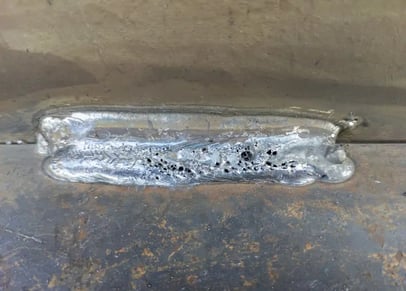What is Porosity in Welding: Typical Sources and Effective Solutions
What is Porosity in Welding: Typical Sources and Effective Solutions
Blog Article
Deciphering the Mystery of Porosity in Welding: Tips for Lessening Problems and Making Best Use Of Quality
In the complex globe of welding, porosity remains a consistent obstacle that can significantly influence the top quality and honesty of welded joints. Recognizing the aspects that add to porosity formation is vital in the quest of remarkable welds. By deciphering the enigma of porosity and applying effective techniques for defect minimization, welders can raise the criteria of their job to achieve exceptional quality end results. As we look into the midsts of porosity in welding, uncovering the tricks to its prevention and control will be paramount for professionals seeking to grasp the art of top notch weldments.
Understanding Porosity in Welding
Porosity in welding, a common problem encountered by welders, refers to the presence of gas pockets or gaps in the bonded material, which can jeopardize the integrity and top quality of the weld. These gas pockets are typically entraped throughout the welding procedure because of numerous aspects such as incorrect securing gas, infected base materials, or incorrect welding criteria. The development of porosity can deteriorate the weld, making it vulnerable to fracturing and rust, inevitably leading to structural failings.
By identifying the significance of keeping appropriate gas shielding, making certain the cleanliness of base materials, and enhancing welding setups, welders can substantially minimize the probability of porosity development. Generally, a comprehensive understanding of porosity in welding is vital for welders to produce high-quality and resilient welds.

Common Root Causes Of Porosity
When checking welding procedures for potential top quality problems, comprehending the typical sources of porosity is necessary for preserving weld stability and protecting against architectural failures. Porosity, identified by the presence of tooth cavities or spaces in the weld steel, can significantly compromise the mechanical properties of a welded joint. One typical source of porosity is incorrect securing gas insurance coverage. Insufficient shielding gas flow prices or incorrect gas mixes can cause atmospheric contamination, causing porosity development.
Additionally, welding at inappropriate specifications, such as excessively high traveling rates or currents, can generate extreme disturbance in the weld pool, trapping gases and triggering porosity. By attending to these typical reasons through correct gas protecting, product preparation, and adherence to ideal welding specifications, welders can lessen porosity and enhance the quality of their welds.
Techniques for Porosity Prevention
Carrying out reliable preventive procedures is important in lessening the occurrence of porosity in welding processes. One strategy for porosity prevention is making sure proper cleansing of the base metal before welding. Impurities such as oil, grease, rust, and paint can anonymous bring about porosity, so detailed cleansing utilizing ideal solvents or mechanical methods is vital.

One more trick safety net is the selection of the appropriate welding consumables. Utilizing top notch filler products and protecting gases that appropriate for the base steel and welding process can significantly minimize the risk of porosity. In addition, preserving appropriate welding parameters, such as voltage, present, take a trip rate, and gas flow rate, is crucial for porosity prevention. Differing the recommended settings can result in improper gas protection and poor fusion, resulting in porosity.
Moreover, utilizing proper welding strategies, such as keeping a consistent traveling speed, electrode angle, and arc size, can aid avoid porosity (What is Porosity). Adequate training of Home Page welders to ensure they comply with best techniques and quality assurance treatments is additionally vital in minimizing porosity defects in welding

Best Practices for Top Quality Welds
One trick technique is maintaining appropriate sanitation in the welding location. Completely cleaning up the work surface and bordering location prior to welding can assist reduce these issues.
Another finest method is to meticulously pick the appropriate welding criteria for the particular products being signed helpful hints up with. This consists of establishing the proper voltage, existing, take a trip speed, and shielding gas circulation rate. Correct criterion selection makes sure ideal weld penetration, fusion, and total top quality. Furthermore, utilizing high-quality welding consumables, such as electrodes and filler metals, can dramatically affect the last weld high quality. Investing in premium consumables can result in stronger, extra long lasting welds with less flaws. By complying with these finest practices, welders can continually create top notch welds that fulfill sector requirements and go beyond client assumptions.
Value of Porosity Control
Porosity control plays a crucial duty in guaranteeing the stability and quality of welding joints. Porosity, characterized by the presence of tooth cavities or voids within the weld metal, can significantly jeopardize the mechanical properties and architectural stability of the weld. Too much porosity damages the weld, making it extra at risk to fracturing, deterioration, and total failing under operational loads.
Effective porosity control is essential for keeping the wanted mechanical properties, such as stamina, ductility, and strength, of the welded joint. What is Porosity. By lessening porosity, welders can enhance the total quality and integrity of the weld, making sure that it meets the efficiency demands of the designated application
Furthermore, porosity control is vital for achieving the wanted visual appearance of the weld. Excessive porosity not only damages the weld yet also diminishes its visual appeal, which can be crucial in industries where appearances are very important. Appropriate porosity control techniques, such as utilizing the right shielding gas, regulating the welding criteria, and ensuring correct cleanliness of the base products, are important for producing high-quality welds with very little flaws.

Verdict
In conclusion, porosity in welding is an usual flaw that can endanger the top quality of the weld. It is necessary to manage porosity in welding to guarantee the integrity and stamina of the last item.
Report this page